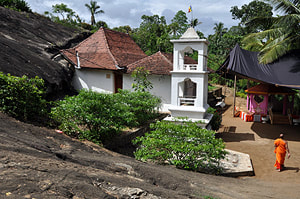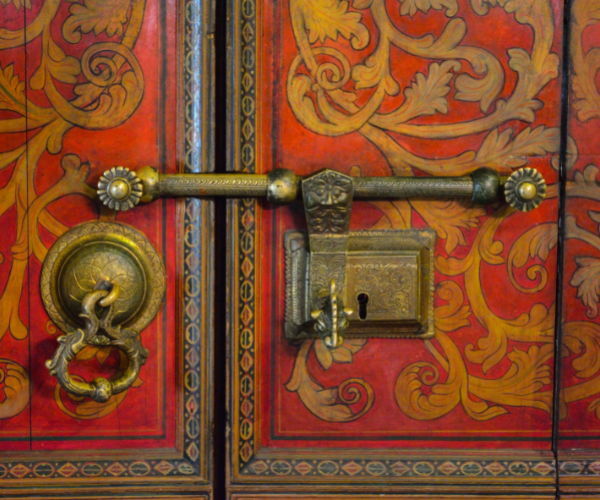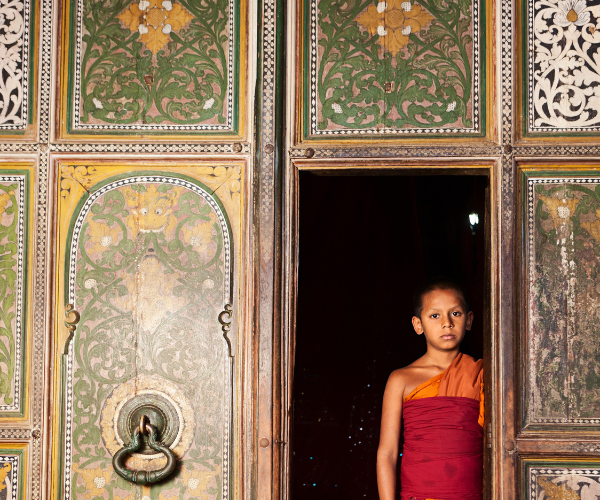Degaldoruwa Cave Temple – vibrant ancient Kandyan art – By Arundathie Abeysinghe

 Situated in Amunugama, approximately seven kilometers from Kandy City and considered as a Cave Temple with Kandyan era paintings and architecture, Degaldoruwa Raja Maha Viharaya is well-known among local and foreign tourists due to the magnificent intriguing multi-colored artworks of *Kandyan Kingdom that adorn its walls.
Situated in Amunugama, approximately seven kilometers from Kandy City and considered as a Cave Temple with Kandyan era paintings and architecture, Degaldoruwa Raja Maha Viharaya is well-known among local and foreign tourists due to the magnificent intriguing multi-colored artworks of *Kandyan Kingdom that adorn its walls.
According to chronicles, the cave of the Temple has been hollowed out of a rock (by breaking the rocks) that rose to a height of around 40 feet (approximately 12 meters) and shelters the Shrine Room as well as an entrance (an area leading to the Shrine Room). The Temple had been constructed at a location where two rocks were touching each other from above and below and the rock mass has a height of approximately 40 feet (approximately12 meters).
Construction of the Temple has been initiated by King Kirthi Sri Rajasinghe (1747 – 1780), a great patron of Kandyan arts. According to chronicles, some of the superior Kandyan temple paintings were done during his reign. As King Kirthi Sri Rajasinghe passed away before the construction of the Temple was complete, it was completed by his younger brother King Rajadhi Rajasinghe (1782-1798). After completion of the Temple, King Rajadhi Rajasinghe bestowed the custody of the Temple to a very learned monk, Venerable Moratota Dhammarakkita Nayaka Thera who was also his teacher.
Paintings at the Temple are renowned for their exquisiteness and are indicative of the customs and social conditions that prevailed during the Kandyan era including the attire worn by inhabitants of the Kandyan Kingdom as well as their dwellings. The paintings display a distinctive difference between the garments worn by those inhabiting up-country and low-country regions. According to chronicles, these works of art had been created by a team of painters headed by *Devendra Mulachari.

Paintings at the Temple are unique. The elements in them, humans, trees and animals are of a uniform size unlike paintings in the majority of temples in Sri Lanka. According to scholars, trees (in the paintings) are depicted in a stylized form with the leaves and branches spreading out on either side. A stream can be identified by a few fish swimming, a unique feature. There are also floral decorations in the paintings. Uniforms of the attendants in the paintings display the royal insignia, whereas the elephants are splendidly embellished and adorned. Predominant colors of the paintings are red and green. These colors had been made with raw materials taken from the bark of trees found in the adjacent hamlet.
These paintings are recognized as some of the best examples of Kandyan era paintings. Four *Jathaka tales are depicted among the paintings at the Cave Temple, the most popular being the *Vessantara Jathaka story.
Degaldoruwa Tamba Sannasa (meaning Copper Plate Grant) of King Rajadi Rajasinha describes the construction details of the Temple.
Directions: From Kandy, travel along Kandy-Lewella Road over Lewella Bridge to reach Degaldoruwa Cave Temple or travel along Kandy-Kundasale Road and turn off at Nattarampota Craft Village.
- Devendra Mulachari – Mulachari (meaning artificer, a title granted by royals of the Kandyan Kingdom to an artist well versed in at least five arts and crafts). Devendra Mulachari worked under three Kings: Kirthi Sri Rajasinha (AD 1747-1782), Rajadhi Rajasinha (1782-1798) and Sri Wickreme Rajasinha (1798-1815). He was one of the most brilliant designers and royal artificers. He designed and constructed (under his supervision) some of the most historic monuments in the Kandyan Kingdom, including the Pattirippuwa (Octagon of the Sri Dalada Maligawa or Temple of the Sacred Tooth Relic), the Cloud Wall (Walakulu Bemma) surrounding the Maligawa, Diyarella Bemma (Ornamental Wall surrounding *Kandy Lake) and *Audience Hall (Magul Maduwa).
- Jathaka tales – A voluminous body of literature native to India based on the previous births of the Buddha. According to Peter Skilling, this genre is “one of the oldest classes of Buddhist literature. Jataka tales illustrate the many lives, acts and spiritual practices that are required during the long path to Buddhahood (a title is commonly utilzed for Gautama Buddha, the founder of Buddhism, who is often simply known as “the Buddha”.
- Kandyan Kingdom – A monarchy of Sri Lanka, located in the central part of the island founded in the late 15th century and endured until the early 19th century. Kandyan period covers the history of Sri Lanka from 1597–1815. After the fall of the Kingdom of Kotte, Kandyan Kingdom was the last independent monarchy of Sri Lanka and played a major role throughout the history of Sri Lanka. The Kingdom managed to remain independent from both the Portuguese and Dutch rule (who controlled coastal parts of Sri Lanka). Yet, it was colonized by the British Colonials in 1815 until Sri Lanka gained Independence in 1948.
- Peter Skilling – A Canadian citizen and a resident of Thailand, he received a PhD and a Habilitation in Paris (Ecole Pratique des Hautes Etudes). His main field of research are archaeology, history, and literature of Buddhism in South and Southeast Asia.
- Vessantara Jataka Story – One of the most popular Jataka of Theravada Buddhism that describes the story of one of the Buddha’s past lives, a very compassionate and generous prince, Vessantara who gives away everything he owns including his children. The story displays the virtue of perfect generosity.








